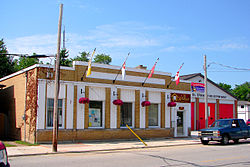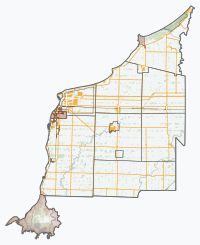Oil Springs | |
|---|---|
| Village of Oil Springs | |
 | |
| Nickname: Canada’s Premier Oil Town | |
| Coordinates: 42°47′N 82°07′W / 42.783°N 82.117°W | |
| Country | |
| Province | |
| County | Lambton |
| Settled | 1850s |
| Incorporated | 1865 |
| Government | |
| • Mayor | Ian Veen |
| • Federal riding | Sarnia—Lambton |
| • Prov. riding | Sarnia—Lambton |
| Area | |
| • Land | 8.19 km2 (3.16 sq mi) |
| Population (2011)
[1] | |
| • Total | 648 |
| • Density | 79.1/km2 (205/sq mi) |
| Time zone | UTC-5 ( EST) |
| • Summer ( DST) | UTC-4 ( EDT) |
| Postal Code | N0N 1P0 |
| Area code(s) | 519 and 226 |
| Website | www.oilsprings.ca |
Oil Springs is a village in Lambton County, Ontario, Canada, located along Former Provincial Highway 21 south of Oil City. The village, an enclave within Enniskillen Township, is the site of North America's first commercial oil well. It is home to the Oil Museum of Canada.
History
Before the village was formed, the indigenous people already knew about the gum beds and used the sticky oil to waterproof their canoes. [2] The place, originally called Black Creek, became the site of North America's first commercial oil well when asphalt producer James Miller Williams set out to dig a water well in September 1858 and found free oil instead. [3] [4]
Williams' discovery triggered North America's first oil rush and the village's name was changed to Oil Springs that same year. [5] Within a few years, Oil Springs was a bustling town with four thousand residents and in its peak days boasted paved roads, horse-drawn buses and street lamps.
John Henry Fairbank, a surveyor turned oil man who came to Oil Springs in 1861, bought some property and despite incurring debts and suffering family tragedies, Fairbank struck it rich, founding the successful Fairbank Oil Company that is now the oldest petroleum company in the world. He also invented the jerker line, a method used to pump oil to the surface from multiple wells using a shared steam engine. Jerker lines are still used to pump oil in Oil Springs today. [2] [6]
On January 16, 1862, John Shaw using a springboard to chip through rock, created Canada's first oil gusher (located on Gypsie Flats Road). [7] It shot oil from over 60 metres (200 ft) below ground to above the treetops at a rate of 3000 barrels per day. [8] A year later, a plank road was built from Oil Springs to Wyoming rail station. [5]
In 1865, the place separated from Enniskillen Township and was incorporated as a village. A year later, Bernard King struck oil at Petrolia, 11 kilometres (6.8 mi) north of Oil Springs. Petrolia quickly replaced Oil Springs as Canada's oil capital, leaving Oil Springs almost abandoned. [5]
In 1881, more oil was discovered at a deeper level, resulting in another oil boom for Oil Springs. Two oil pipelines were built to Petrolia, and in 1886, a spur line of the Canada Southern Railway connected the village to Oil City (operating until 1960). [5]
In 1914, Charles Fairbank, son of John Henry, found a gas gusher in Oil Springs that was deemed the biggest gusher in Canada. [5] [6]
In the 1930s, a fire destroyed all of the original oil rigs on William's property and by 1974, the last receiving station of Imperial Oil closed. [6]
In 2008, the 150th anniversary of Williams' discovery, Canada Post issued a stamp commemorating this first commercial oil well, featuring portraits of Charles Tripp and Williams. [9]
Demographics
In the 2021 Census of Population conducted by Statistics Canada, Oil Springs had a population of 647 living in 267 of its 283 total private dwellings, a change of -0.2% from its 2016 population of 648. With a land area of 8.14 km2 (3.14 sq mi), it had a population density of 79.5/km2 (205.9/sq mi) in 2021. [12]
| 2021 | 2016 | 2011 | |
|---|---|---|---|
| Population | 647 (-0.2% from 2016) | 648 (-8.0% from 2011) | 704 (-1.8% from 2006) |
| Land area | 8.14 km2 (3.14 sq mi) | 8.19 km2 (3.16 sq mi) | 8.18 km2 (3.16 sq mi) |
| Population density | 79.5/km2 (206/sq mi) | 79.1/km2 (205/sq mi) | 86.1/km2 (223/sq mi) |
| Median age | 40.8 (M: 40.8, F: 41.2) | 45.6 (M: 43.0, F: 48.1) | 41.5 (M: 40.4, F: 43.7) |
| Private dwellings | 265 (total) | 285 (total) | 302 (total) |
| Median household income | $76,288 |

References
- ^ a b c "Census Profile, 2016 Census: Oil Springs, Village". Statistics Canada. Retrieved June 17, 2019.
- ^ a b "Newsworthy Nuggets". The Village of Oil Springs. Retrieved 2011-02-23.
- ^ Elizabeth Kolbert "Unconventional crude" New Yorker 2007-11-12 page 46
- ^ New York Times 1866-03-22 [1], [2] (JPG images)
- ^ a b c d e "High Times in Oil Springs". The Village of Oil Springs. Archived from the original on 2011-07-06. Retrieved 2011-02-23.
- ^ a b c "History of Oil Springs". The Village of Oil Springs. Archived from the original on 2011-07-06. Retrieved 2011-02-23.
- ^ Gray, Earle. (2008). Ontario's petroleum legacy : the birth, evolution and challenges of a global industry. Edmonton: Heritage Community Foundation. p. 32. ISBN 978-1-4593-3970-5. OCLC 842999352.
- ^ "The Shaw Gusher". The Village of Oil Springs. Archived from the original on 2009-12-06. Retrieved 2011-02-23.
- ^ "Canada Post - Collecting". Archived from the original on 2012-10-09. Retrieved 2011-04-09.
- ^ Statistics Canada: 1996, 2001, 2006 census
- ^ "Oil Springs census profile". 2011 Census of Population. Statistics Canada. Retrieved 2012-02-09.
- ^ "Population and dwelling counts: Canada, provinces and territories, census divisions and census subdivisions (municipalities), Ontario". Statistics Canada. February 9, 2022. Retrieved March 30, 2022.
- ^ "2021 Community Profiles". 2021 Canadian Census. Statistics Canada. February 4, 2022. Retrieved 2022-04-27.
- ^ "2016 Community Profiles". 2016 Canadian Census. Statistics Canada. August 12, 2021. Retrieved 2019-06-17.
- ^ "2011 Community Profiles". 2011 Canadian Census. Statistics Canada. March 21, 2019. Retrieved 2012-02-09.
- ^ "2006 Community Profiles". 2006 Canadian Census. Statistics Canada. August 20, 2019.
- ^ "2001 Community Profiles". 2001 Canadian Census. Statistics Canada. July 18, 2021.



